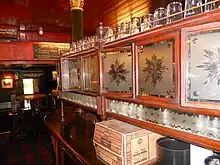Snob screen
A snob screen is a device found in some British public houses of the Victorian era. Usually installed in sets, they comprise an etched glass pane in a movable wooden frame and were intended to allow middle class drinkers to see working class drinkers in an adjacent bar, but not to be seen by them,[1] and to be undisturbed by the bar staff.[2]

A row of snob screens, at The Lamb, in Bloomsbury
Pubs with surviving snob screens include:
- The Bartons Arms, Birmingham[1]
- Bunch of Grapes, London SW3[3]
- The Champion, London [4]
- The Crown and Greyhound, Dulwich Village London (the screens have been re-sited)[5]
- The Gate, London N22[6]
- John Leslie's, Ratcliffe Terrace, Edinburgh
- The Lamb, Bloomsbury, London[2]
- Posada, Wolverhampton[7]
- Prince Alfred, Maida Vale, London[1]
- Princess Louise, Holborn, London[1]
- Crown, London N1[8]
- Nova Scotia, Bristol[9][10]
References
- Brandwood, Geoff (2013). Britain's Best Real Heritage Pubs. CAMRA Books. ISBN 978-1-85249-304-2.
- "Snob Screens". Beer Lens. Retrieved 21 December 2015.
- "Bunch of Grapes". Historic Pub Interiors. Campaign for Real Ale. Retrieved 21 December 2015.
- "The Champion".
- "Crown & Greyhound". Historic Pub Interiors. Campaign for Real Ale. Retrieved 21 December 2015.
- "The Gate". Historic Pub Interiors. Campaign for Real Ale. Retrieved 21 December 2015.
- "Posada, Wolverhampton". Historic Pub Interiors. Campaign for Real Ale. Retrieved 21 December 2015.
- "Crown". Historic Pub Interiors. Campaign for Real Ale. Retrieved 21 December 2015.
- Stapley, Fiona (2015). Good Pub Guide 2016. Random House. ISBN 9781473527492.
- "Nova Scotia". The Good Pub Guide. Retrieved 21 December 2015.
This article is issued from Wikipedia. The text is licensed under Creative Commons - Attribution - Sharealike. Additional terms may apply for the media files.